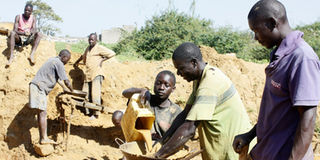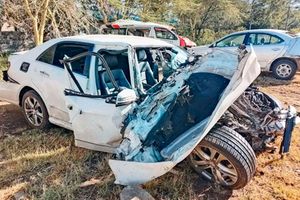Premium
Rosterman, our boulevard of broken dreams for gold

Miners hard at at work at the Rosterman Mines in Kakamega County.
What you need to know:
- Today, apart from artisanal miners eking a living from abandoned pits, the Western belt gold mining is considered a failed eldorado.
- The project is part of a primary gold field — the Lake Victoria Gold fields.
Ninety years ago, a short-lived gold rush took place in Kakamega, which saw tens of colonial prospectors pitch camp in Western, establishing clubs, banks, hotels and businesses — all in the hope that the region would mimic the 1886 Witwatersrand Gold Rush that led to the establishment of Johannesburg in South Africa.
Soon, most of the mines were quickly exhausted, apart from Rosterman Mines, which had leased 155 acres. Today, apart from artisanal miners eking a living from abandoned pits, the Western belt gold mining is considered a failed eldorado.
The former mine houses Rosterman Rehabilitation Centre for the disabled, and the ruins of a substantial colonial-era gold mine inside the fenced compound tells a tale of a once-lucrative venture that gave birth to Kakamega town.
About 200 metres from the centre lives Mzee Asteriko Otsuku Kavole. At 86, he has lived long enough to witness the transformation of a small area that once thrived on the settler’s gold mining activities.
“Rosterman was a beehive of activity complete with cranes and explosion of rocks every other day. You would never ever tell night from day,” says Mr Kavole.
We found him seated outside his scantily-stocked shop, dozing in the afternoon heat, a walking stick in his hand. The murram road leading to the former mines, located a few kilometres from Kakamega town, betrays a rich history of a company that had built its own hospital.
Rehabilitation centre
Besides the white-washed buildings at the rehabilitation centre, ruins from the mining days dot a vast section of the back of the compound, all of them now sealed and the protruding stained landmark stones the only remaining sign of what was once the mining nerve centre.
But in this compound lies the end of a 1930s dream that would have transformed Kakamega into the Gold City, had the mines not been exhausted fast. For years, Rosterman Gold Mine, registered on February 3, 1935, basked in the international limelight with its shares floated on the London Exchange and under the management of Bewick , Moreing and Co Ltd — a famous British international mining and civil engineering consultancy.
It was a venture that completely changed the face of Rosterman village into a small lively 24-hour economy in the 1930s into the 1940s, complete with social amenities, long before Kakamega town came to be, says Mzee Kavole, whose father worked at the Rosterman Gold Mine.
The mines were operational during the 1930s but were shut in the 1950s following the Mau Mau uprising.
Mzee Kavole’s shop is part of the legacy of mining in the area. It served as a carpentry shop. Behind it is an entire compound of what used to serve as a hospital and other social amenities.
To the left of the shop, about 50 metres away, a field that served as football pitch and cinema watching grounds for the Rosterman residents on weekends is now a dumping site, with garbage littered all over emitting a putrid stench.
Neglected roads
Right in front of the shop, just across the road, a thicket covers the very first mining site that collapsed, killing 24 people, and which saw the mine moved to the rehabilitation centre.
“When I look around, I wonder at how much things have changed,” he says.
“The roads are now neglected and no longer tarmacked. It is a shell of its former self, nothing to show that it gave birth to Kakamega town,” he states, noting with dissatisfaction what he considers a serious downgrade of the little mining town.
“If you saw Rosterman then, it was such a beautiful town, well lit, with the cinema halls, good roads and social amenities — no comparison to what we see today,” he claimed.
His father, Mr Kavole Abuneri, managed the stone crusher at the Mill House, where the processing happened, and he had the privilege of getting a guided tour of the underground mining tunnels, at least up to the second station.
The children would be lowered into the tunnels via cranes that operated round the clock. According to Mzee Kavole, the tunnels were several kilometres long — all the way to Sigalala, about 16 kilometres to the north east and about six kilometres to Shimanyiro, to the south west.
Some of the buildings used for mining still exist, as well as some of the houses where the miners lived. Mzee Kavole claims important records and maps were buried in the mining tunnels that were permanently sealed by the British as they left the site. No one has ever opened the place again.
“They did not go with their stuff,” he said. “They did not leave because the gold was over, they left because of the Mau Mau uprising,” he claims.
Sh164 billion
However, that may not be true. Company records indicate that the gold reef was exhausted and Mau Mau activities were mainly in Central Kenya. Today, it is these ruins that modern day gold prospectors are eyeing, as they form a key part of a multibillion-shilling venture that has been going on in the region for the past three decades, even though the investors insist they are yet to strike gold. The mine is included in the lucrative Lirhanda Corridor project valued at Sh164 billion.
The gold deposits along the Lirhanda Corridor, which cuts across Kakamega, Vihiga, Kisumu and Siaya counties, holds an estimated 1.32 million ounces (37,000 kilos) of the element with a handsome gold grading of 12.6 grammes per tonne (g/t) — believed to be one of the highest grades of gold deposits in Africa.
Every mine gives the level of the gold grade. Ten grammes a tonne is considered high grade gold, which is the case at the Isulu/Bushiangala site. The project is considered significant as it is believed to be the highest grade under development anywhere in Africa. The Western Kenya project rides on a sturdy historical gold production background with its roots at the colonial Rosterman mines estimated at 12.3g/t.
The project is part of a primary gold field — the Lake Victoria Gold fields. It is a high quality project with high grade gold resource sitting in a geologically rich and under-explored greenstone gold region.
The project has an inferred resource grade of 12.6 g/t, which basically means it should be a high reward for the investor.
Last month, Tanzania-based British mining company Shanta Gold announced taking over the project, which has seen a change of hands several times over the years.
After taking over from Barrick Gold’s Acacia Mining, Shanta is now focused on unlocking value and progressing the project into its second phase as it plans for it.
It could take up to five years to build a mine, after all the ground work has been done and economic viability is established.
So far, four prospective exploration camps have been recognised across the belt — Kakamega, Barkalare, Yala and Wagusu.
The Kakamega gold camp hosts the Lirhanda Corridor. Its principal prospects are two gold ore bodies — Isulu and Bushiangala. Both ore bodies lie within the Lirhanda corridor on the Western margin of the Kakamega gold camp.
The gold deposits in Isulu and Bushiangala are believed to be one of the highest grading for gold deposits in Africa.
Shanta’s deepest hole is 1.2 kilometres drilled by Acacia in the Isulu ore.
The prospecting process, however, is regarded with a lot of suspicion and even subtle resistance.
Locals around the Isulu/Bushiangala prime ore bodies, say they have no idea where exactly the prospectors are targeting, as it remains a top industrial secret.
For locals who are represented in the project through a community team, the question is how they stand to benefit from the lucrative venture, should it turn out to be economically viable.





